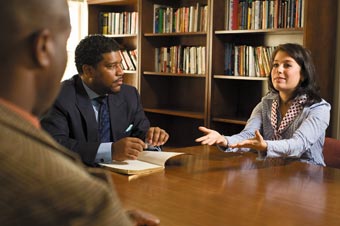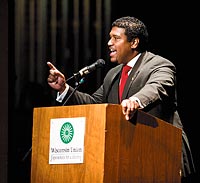New diversity chief ready for challenges ahead
As Damon Williams conducts meetings all around campus, he hears many of the same questions and thoughts from different groups.

Damon Williams (center), vice provost for diversity and climate, holds a discussion with students Le Var Charleston (left) and Audrey Buchanan (right) in his office at Bascom Hall.
Photo: Bryce Richter
“We are struggling with respect to campus diversity and the need to find the way to turn the corner,” he says. “We need to find the way to create real change. How can we do it? Where do we start? How can we truly make a difference? We had multiple diversity plans. But is it enough? Can you tell us what to do? Can you help?”
The questions for the new vice provost for diversity and climate are admittedly weighty, leaving him to joke that the job requires him to leverage the agility of a “Jedi knight becoming wise in the ways of the force” and the wisdom of Yoda, to borrow from “Star Wars” parlance.
Williams, who began his new position in August, comes to campus at a key moment in time.
Plan 2008, UW–Madison’s 10-year diversity plan, is coming to an end, putting him in a position to create a blueprint for the future of the issue on campus. The plan has been a mixed success, resulting in only small increases in the number of students, faculty and staff of color. But the plan has embedded consciousness of diversity into the way the university operates and there is a strong commitment to the future.

Damon Williams speaks to a large group of students at the Multicultural Student Orientation held at the Wisconsin Union Theater.
Photo: Bryce Richter
“My response to those individuals that I’ve seen on the street is that there are no magic diversity bullets,” he says. “The challenge is one that is systemic. The challenge is one that’s great. As we look at and we dissect the issues to any lengths, it is a challenge of incredible weight.
“It’s so wonderful for me to be a part of a community that I know is deeply committed to making a difference, deeply committed to transformation, deeply committed to change,” he adds.
Williams, who serves as the university’s chief diversity officer, was the assistant vice provost in the Office of the Vice Provost for Multicultural and International Affairs at the University of Connecticut-Storrs. He is nationally recognized in the areas of diversity, leadership and organizational change. He succeeded Bernice Durand, who retired.
As one can imagine, coordinating diversity at UW–Madison is a huge undertaking, spanning hundreds of people, programs and units.
To make the process more manageable, Williams is focusing on planning through the creation of a strategic framework document. His four main goals for the campus for 2008-09 include engaging the campus community, understanding campus diversity capabilities, building an identity for his office and developing a strategic action plan. The plan, in its final draft stages, will be available to campus soon.
By way of strategy, Williams has started by listening, in unit or individual “join up” meetings, to hear views. By his count, Williams has met or spoken before nearly 2,000 members of the campus community since he arrived.
During the academic year, he plans to have thematic discussions centering on different topics, such as disability issues, gender issues, or LGBTQ issues. He also hopes to host a diversity-themed retreat to focus on key issues.
A diversity audit will review programs, successes and opportunities with department chairs and deans. Enhanced communications will put the issue in front of more people on campus and in the community. And in the future, he plans to bring in an external review team for an evaluation.
As he launches into this process, Williams notes that his definition of diversity is more broadly encompassing than simply the color of one’s skin.
“I do not view myself as the vice provost for race and ethnicity,” he says. “I view myself as the vice provost for this evolving idea of diversity. My conception of that idea is not one that loses sight of historic issues of access and equity, but it also recognizes the important role of diversity experiences in the curriculum an co-curriculum for all students.
“Mine is one that believes that a more powerful conversation comes from a collective conversation,” he adds. “And through the years, I’ve groomed myself to help us with that conversation on campus.”
Chancellor Carolyn “Biddy” Martin officially welcomed Williams at the Sept. 23 campus diversity forum. “I feel that we’re enormously fortunate,” she said of Williams at the event. “I support his philosophy of inclusive excellence and the definition of learning that includes diversity at its core, and I look forward to working with Damon and the rest of my colleagues to see what we can do here to move things forward.”
The challenge is great, but Williams says he is relishing the opportunity to be a part of the UW–Madison community.
“I take so seriously the responsibility that has been given to me to be a part of the leadership discussion, to help to shape what that vision might look like,” he says.
“This work takes time and commitment. If we are lucky, we are going to make positive sustainable gains. UW–Madison has made incredible investments in the area of diversity, but in the next generation of our work, the focus must be on implementing this work with even more rigor, discipline, and focus. That’s the legacy that we carry as we continue to lift this work.”
Tags: campus administration, diversity



